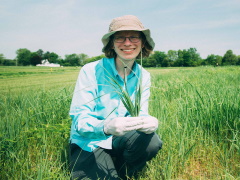Features
Microbial benefits
Date: 2019-09-16 11:53:36.0
Author: Jon Evans

MSU's Ashley Shade in a field of switchgrass.
Photo courtesy of MSU.
When looking for ways to improve bioenergy crops such as switchgrass and miscanthus, by enhancing their drought tolerance or their ability to grow on poor quality soils, scientists usually focus on genes. Indeed, the US Department of Energy (DOE) recently launched a major initiative to develop enhanced bioenergy crops through genomics-based research.
Two of the projects being funded under this initiative are being conducted by teams at the Donald Danforth Plant Science Center in St. Louis, Missouri. One will aim to predict the functions of hundreds of uncharacterized plant genes that could be important for stress tolerance in a range of potential bioenergy crops. Many of these uncharacterized genes, termed ‘Deep Green’ genes, have been found in a wide range of different land plants and algae, suggesting they play an important role in photosynthesis.
“This project will help fill a major gap in understanding structures and functions for hundreds of plant and green algal proteins and the genes that encode them,” says James Umen, a principal investigator at the Danforth Center. “These genes hold untapped potential as resources for improving bioenergy crops.”
The other project being conducted at the Danforth Center will investigate the gene networks responsible for the natural drought tolerance of sorghum, in the hope of transfering that ability to other bioenergy crops. This will involve creating numerous mutant strains of sorghum, identifying which genes have been knocked out in those strains and then recording what effect this has on the plant’s drought tolerance.
The DOE is also funding a project being conducted by researchers at the University of California, Davis and Oak Ridge National Laboratory, who will develop drought-tolerant poplar trees as a bioenergy feedstock. This will involve determining the ideotype, or ‘perfect tree’, for growing in drought conditions, and then linking this to underlying genomic targets that will be investigated using the latest CRISPR-Cas9 gene editing tools (see Biofuels could benefit from CRISPR editing).
But genes aren’t the only route to improving bioenergy crops, as shown by a paper in Nature Communications on a study conducted by researchers at Michigan State University (MSU). Rather than focus on genes, these researchers, led by Ashley Shade, investigated the microbes that live on the leaves of switchgrass and miscanthus.
As can be imagined, plant surfaces above the soil, known as the phyllosphere and comprising leaves, stems, flowers and fruit, offer the largest single inhabitable area for microbes on the planet. Previous research has shown that phyllosphere microbes may offer numerous benefits to their host plants, aiding their growth, stress tolerance, and resistance to pathogens and disease, but little is known about what specific microbial species are present and how they change over time. This is what Shade and her colleagues set out to discover.
They did that by taking advantage of fields of miscanthus and switchgrass at MSU's Kellogg Biological Station, which were established in 2008 as part of a biofuel cropping system experiment. Shade and her colleagues collected and analyzed the microbes present on the leaves of these plants, as well as in the soil beneath the plants, every three weeks for one full growing season for miscanthus and two growing seasons for switchgrass.
They found that the microbial populations on the leaves were highly consistent, with certain core species present all the time in all plants of both species. There was also a lot of similarity between the microbes on the leaves and in the soil, showing there is a lot of movement between the two, although the specific distributions did differ. This indicates that the leaf environment actively encourages colonization by specific microbes, rather than being a free-for-all.
Shade and her colleagues now plan to identify which microbial species are most beneficial for the plants, helping to ensure their healthy growth. “Now that we have a whole bunch of community data from the microbiome that includes thousands of taxa, we can understand which of these core members are just hanging out on the plant, and which ones have an impact on growth and health,” she said. “If we can understand how that microbial community is changing its interactions with its host over a season, we might be able to leverage that to benefit the plant.”
The views represented here are solely those of the author and do not necessarily represent those of John Wiley and Sons, Ltd. or of the SCI.
Displaying 2 keywords used to tag this article:
- DG6582 Mens Moncler Down Jackets Gr
- Jules Audemars-Australia Best Quali
